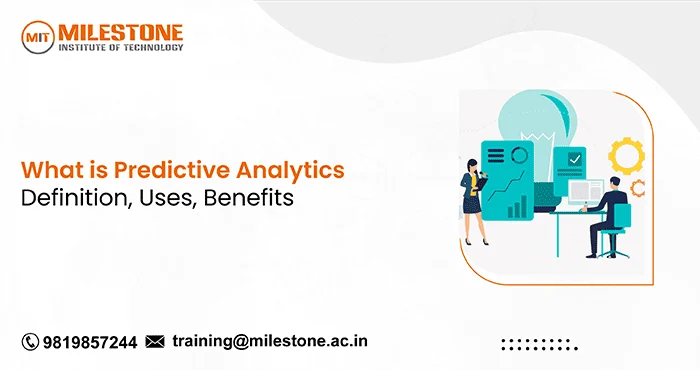Predictive analytics is becoming a main cornerstone in the modern data-driven world of decision-making and revolutionizing how businesses and organizations operate. With the use of machine learning algorithms, statistical methods, and historical data, predictive analytics is able to accurately anticipate future events. In this blog, we will be understanding
what is predictive analytics, its uses, benefits, different types of prediction modeling, and many more in detail.
What is Predictive Analytics? (Definition)
Predictive Analytics is an important branch / part of advanced analytics which is actually used for making proper predictions of future based events. It employs various statistical techniques, including data mining, machine learning, and predictive modeling, to analyze current and historical data and identify patterns. It uses these patterns to forecast future events, trends, and behaviors.
In essence, it involves extracting information from data sets to determine patterns and predict future outcomes and trends. This process often involves a combination of data gathering, data analysis, and the use of sophisticated algorithms to generate predictions. Providing the best estimate of what will occur in the future is the aim, which goes beyond understanding what has already occurred.
What is Use of Predictive Analytics
Predictive analytics is utilized across a wide range of industries to address various challenges and improve decision-making processes. Here are some of the essential uses of predictive analytics mentioned below:
- Marketing and Sales: Predictive analytics helps in understanding customer behavior, predicting future buying trends, and identifying the most profitable customer segments. This allows businesses to tailor their marketing campaigns, improve customer targeting, and increase sales.
- Finance: In the financial sector, institutions use it for risk management, fraud detection, credit scoring, and investment forecasting. By analyzing historical financial data, organizations can predict future market trends, assess the risk of loans, and detect fraudulent activities.
- Healthcare: Predictive analytics plays a crucial role in healthcare by forecasting patient outcomes, improving diagnosis accuracy, and optimizing treatment plans. It helps in predicting disease outbreaks, managing hospital resources, and personalizing patient care.
- Supply Chain Management: Companies use it to forecast demand, optimize inventory levels, and improve supply chain efficiency. Businesses may lower expenses and increase customer satisfaction by making sure they have the proper quantity of stock by forecasting future demand.
- Human Resources: HR departments use it to enhance recruitment processes, predict employee turnover, and improve employee performance management. It helps in identifying the best candidates, understanding employee retention factors, and planning for future workforce needs.
- Retail: Retailers use predictive analytics to optimize pricing strategies, manage inventory, and improve customer experience. It enables them to forecast demand for products, set competitive prices, and personalize offers for customers.
Different Types of Predictive Modeling
Predictive modeling involves the creation of models that can predict future outcomes based on historical data. There are several types of predictive models, each suited for different types of data and prediction tasks.
- Regression Models: These models are used to predict a continuous outcome variable based on one or more predictor variables. The most common examples are linear and logistic regression. Linear regression predicts numerical values, while logistic regression is used for binary outcomes.
- Classification Models: These models are used to predict a categorical outcome. Decision trees, random forests, and support vector machines are popular classification models. They are often used in tasks such as spam detection, customer segmentation, and image recognition.
- Time Series Models: These models analyze time-ordered data points to forecast future values. Common time series models include ARIMA (AutoRegressive Integrated Moving Average) and exponential smoothing. They are widely used in stock market analysis, weather forecasting, and sales forecasting.
- Clustering Models: Clustering involves grouping data points into clusters based on their similarities. K-means and hierarchical clustering are common techniques. These models are used for customer segmentation, anomaly detection, and image compression.
- Neural Networks and Deep Learning: These advanced models are inspired by the human brain and are capable of handling large amounts of data and complex patterns. They are used in tasks such as image and speech recognition, natural language processing, and game playing.
- Ensemble Models: To increase forecast accuracy, ensemble approaches integrate several models. Techniques like boosting, bagging, and stacking fall under this category. Random forests and gradient boosting machines are popular ensemble models.
What are the Benefits of Predictive Analytics?
Predictive analytics offers numerous benefits to organizations, enabling them to make more informed decisions and stay competitive. Some of the key benefits include:
- Improved Decision Making: Predictive analytics aids in decision-making for enterprises by offering data-driven insights. It facilitates their ability to recognize opportunities, lower risks, and forecast market trends.
- Cost Reduction: Predictive analytics can help organizations optimize their operations, reduce waste, and lower costs. For example, by predicting equipment failures, companies can perform maintenance before costly breakdowns occur.
- Enhanced Customer Experience: By understanding customer behavior and preferences, predictive analytics allows businesses to personalize their offerings and improve customer satisfaction. This leads to higher levels of consumer loyalty and retention.
- Increased Revenue: Predictive analytics helps businesses identify the most profitable customer segments, optimize pricing strategies, and improve marketing campaigns. This results in increased sales and revenue growth.
- Risk Management: Predictive analytics enables organizations to assess and mitigate risks more effectively. Finance professionals use tools to detect fraud, evaluate credit risk, and forecast market trends. It helps the industrial sector identify breakdowns in equipment and optimize maintenance plans.
- Competitive Advantage: By using predictive analytics to make proactive decisions and keep ahead of market trends, organizations may gain a competitive advantage. They can respond quickly to changes in the market and capitalize on new opportunities.
Best Place to Learn Data Analytics
There are many ways you can learn
data analytics, either it could be online or else offline. In these two options, we will suggest that learning offline would be the best for quality learning. As per the research and students reviews, Milestone Institute of Technology provides personal guidance, practical training from experienced faculties, career guidance, and many more for students career success.
Frequently Asked Questions
What skills are needed for predictive analytics?
To excel in predictive analytics, one needs a combination of technical and analytical skills. Key skills include statistical analysis, machine learning,
data mining, data visualization, programming (Python, R), and domain knowledge. Strong problem-solving abilities and critical thinking are also essential.
How is predictive analytics different from descriptive analytics?
Descriptive analytics concentrates on reducing historical data to help understand the past. Predictive analytics, on the other hand, makes predictions about the future using historical data. While descriptive analytics provides insights into past performance, it helps in forecasting future trends and behaviors.
What software tools are commonly used for predictive analytics?
Commonly used tools include
Python libraries like scikit-learn and TensorFlow, R programming language, SAS, and IBM SPSS. These tools offer a range of functionalities for data preprocessing, modeling, and visualization.




